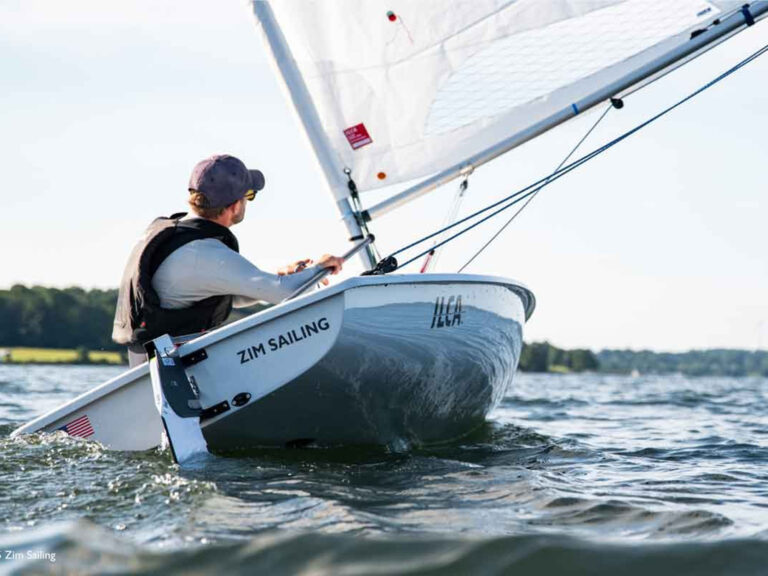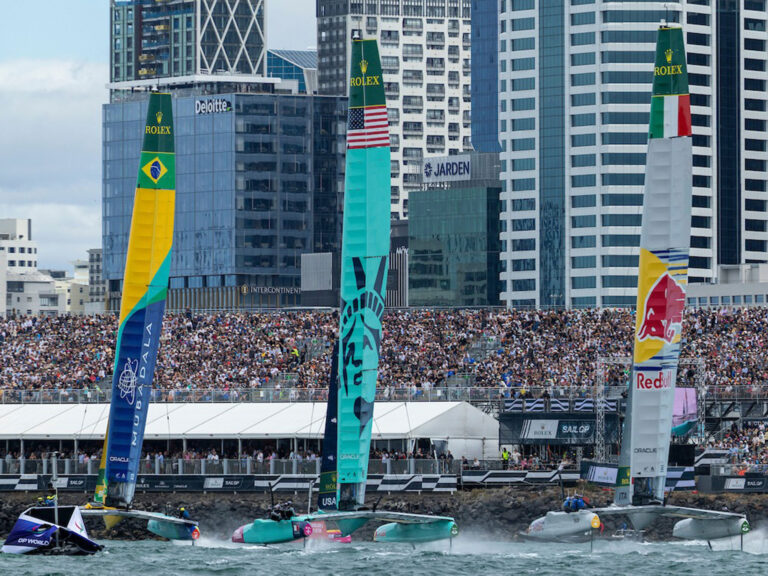From the drawing board of the man who helped engineer the Auckland Sky Tower and, more recently, designed the Viper 830, comes a speedy prototype called the T590. Thats 5.9 meters, or about 19 feet LOA. The T is for Steve Thompson, who quit his career as a construction engineer five years ago and turned to his passion for yacht design.
Like his other designs, which include Chris Bouzaids 30-foot Wairere, the 590 is light (about 1,000 pounds), with a narrow waterline beam and a fair amount of rocker (fore-and-aft hull curvature). The latter two characteristics help it go upwind, and Thompson relies on its low displacement to give it downwind legs.
A shallow, double-bottomed cockpit is rigged with hiking straps, and the side decks are wide for comfortable, effective hiking. Controls lead to the front of the cockpit beneath a removable section of deck, which keeps the deck clear and butt friendly, although you cant reach the controls from a hiking position.
The T590s real departure is in its sail plan, which is set on a stayed, carbon rig. Upwind, with two or three crew aboard, a powerful mainsail alone drives the boat. Downwind, you hoist an asymmetric from a channel under the foredeck, adding plenty of horsepower. There are no backstays, but the prebent mast with swept spreaders can handle the chute. Thompsons approach results in a fun boat thats quick and also easy to sail.
I sailed the drop-keel prototype one morning last winter on Auckland Harbor in six to eight knots of breeze. Thompson trimmed the main (there being no jibsheet to attend to), and we hiked out a little. In a puff, I’d feather the boat, and if I lowered the traveler slightly, the boat responded. I’d estimate we were sailing at a little over five knots.
Downwind, the boat moved well as we sailed wide jibing angles, building apparent wind and then carrying the speed down to a deeper angle. We caught up to a ferryboat wave, and our speed jumped at least three knots as the forward sections popped out of the wave. That was a small taste of how much fun this boat would be to sail downwind in breeze and waves.
I put the boat on a shy spinnaker reach and found it had no tendency to wipe out. Just when I thought I was heeling way too much, the extra stability of the flared deck wings would kick in without much fuss.
Jibing came easily enough, with me on the main and Thompson on the chute. For those of you who are dinghy sailors, a roll jibe would come naturally. The only difficulty I had was that–with the mainsheet cleat in front of the traveler–it was hard to switch sides and trim the main properly on the new jibe. Thompson also put a full-length batten in the main, and it was a challenge in light air to pop it onto the new tack. With a third crew aboard to handle the main, I’m sure a practiced roll jibe could be a thing of beauty.
We launched the 590 on a trailer ramp in a drysail park in less than 15 minutes. With its narrow waterline, the boat was tippy at the dock until we lowered the 180-pound keel into its tapered slot. The rudder was a simple, high-aspect blade that slipped easily into its housing, hung on a faired mount in the open transom.
Thompson still has a few things to work out. For one, hes going to rearrange the mechanics of the retractable pole so it doesnt interfere with the chute going up and down. The system for raising and lowering the keel also needs development. But later this year, Thompson hopes to deliver boats in the United States for about $17,000.
If you want to start a one-design fleet for a crew of two or three weighing about 500 pounds–or just have a fast, simple boat for daysailing or Portsmouth Yardstick racing–keep an eye on www. tboat.com or e-mail enquiry@tboats. co.nz (64-9-483-3520).





